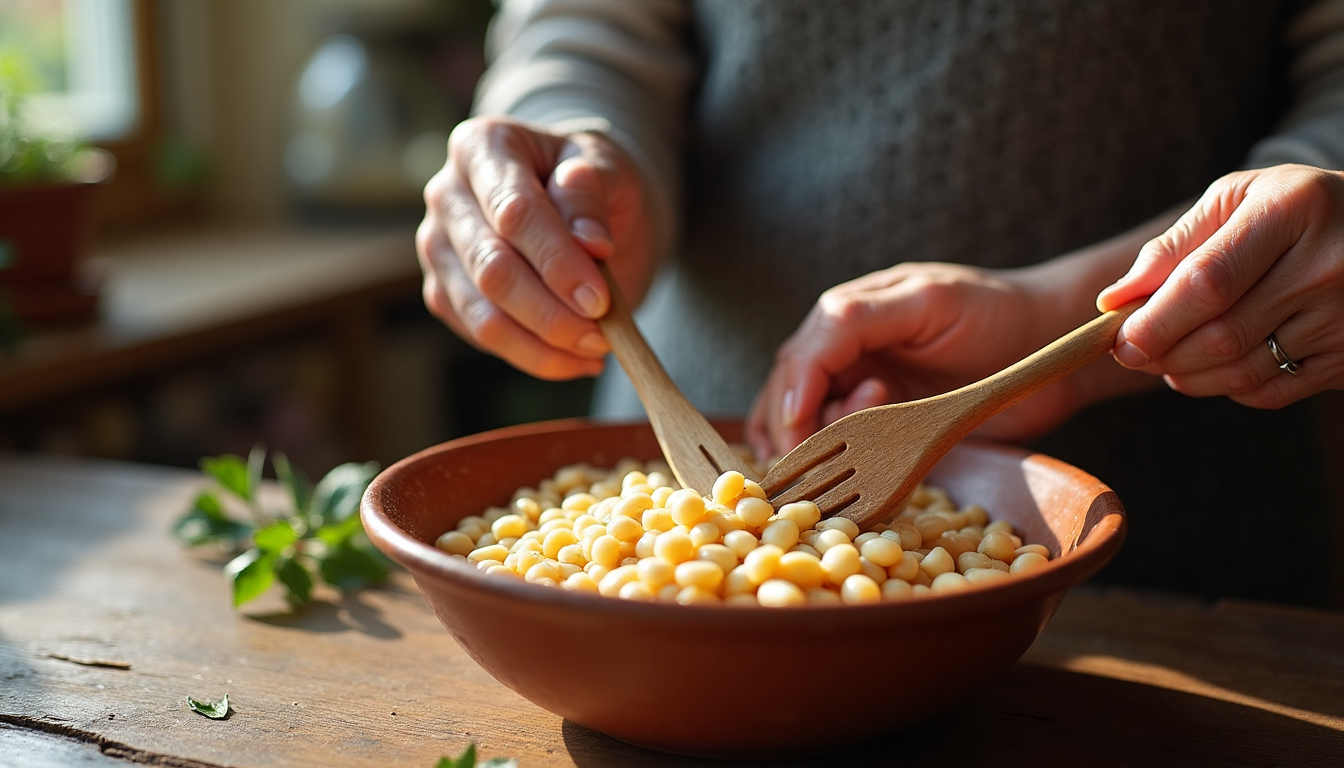Why Your Pasta e Fagioli Tastes Like Sadness (And How My Nonna Would Fix It)

Why Your Pasta e Fagioli Tastes Like Sadness (And How My Nonna Would Fix It)
Spoiler alert: It's not about the recipe.
Let me guess. You've made pasta e fagioli before, following some "authentic" recipe to the letter, and it came out... fine. Not terrible, not amazing. Just fine. Like eating a warm hug that forgot to actually hug you back.
I know because I've been there. Hell, I lived there for years.
The Problem Isn't Your Technique (It's Your Story)
Here's what nobody tells you about pasta e fagioli: this isn't just soup. It's liquid storytelling. It's what happens when you take the scraps from yesterday, the hope for tomorrow, and the wisdom of generations who knew that la cucina povera isn't about being poor—it's about being resourceful.
My nonna used to say, "Marco, you cook with your hands, but you taste with your heart." Took me twenty years to understand she wasn't being poetic. She was giving me the actual recipe.
Most pasta e fagioli recipes treat this dish like it's some kind of Italian minestrone's cousin. They're missing the point entirely. This soup? It's about transformation. About taking beans—humble, patient beans—and convincing them to become something greater than themselves.
Let's Talk About Your Beans (Because Everyone Else Is Lying to You)
Every recipe tells you to drain and rinse your canned beans. Don't. I'm serious. That cloudy liquid you're washing down the sink? That's liquid gold. That's where half the flavor lives.
Instead, do this: Open your cans of cannellini beans (and yes, it HAS to be cannellini—Great Northern beans are fine if you're making "pasta e fagioli-inspired soup," but we're not playing games here). Pour everything—beans AND liquid—into a bowl. Take half the beans and mash them with a fork. Not puree, not blend. Mash. With a fork. Like your ancestors did.
Why? Because you want texture that tells a story. Smooth puree says "I took shortcuts." Whole beans say "I didn't think about this." Roughly mashed beans say "I understand that some things should be broken to become beautiful."
The Pancetta Situation (Or: How to Build Actual Flavor)
Let me address the pancetta thing head-on because I see you vegetarian and vegan cooks rolling your eyes. First—respect. Second—we need to talk about what pancetta actually DOES in this dish so you can replicate that magic.
Pancetta isn't just "Italian bacon" (though that's not wrong). It's a fat delivery system for flavor compounds. When you render it slowly, you're creating a foundational layer of umami that everything else builds on. It's like the bass line in your favorite song—you might not notice it, but without it, everything sounds thin.
For the pancetta devotees: Dice it smaller than you think you need. We want little bombs of flavor in every spoonful, not chunks of meat that overpower everything else.
For the plant-based crew: Two words: mushroom powder. I'm not talking about the stuff you buy in packets. I'm talking about taking dried porcini mushrooms, grinding them into powder, and blooming that powder in good olive oil at the beginning of your cooking process. It won't taste like pancetta, but it will give you that deep, complex foundation you need.
The Mirepoix Conspiracy
Every recipe tells you to dice your onions, carrots, and celery uniformly. This drives me insane. You know why? Because vegetables cook at different rates, and treating them like they're identical is culinary negligence.
Here's what you actually do:
- Onions: Medium dice, started first
- Carrots: Smaller dice (they take longer to soften)
- Celery: Larger dice (it cooks faster and we want some texture)
But here's the real secret: Don't add them all at once. Onions first, let them get translucent and just slightly caramelized. Then carrots. Let them start to soften. THEN celery. This way, everything finishes cooking at the same time, but each vegetable maintains its individual character.
Your nonna didn't have a food processor that could make perfect uniform dice. She had a knife, patience, and the understanding that different ingredients need different treatment.
The Garlic Situation (Or: Why You're Probably Burning It)
Four cloves of minced garlic sounds about right, except most people add it wrong. Garlic isn't just flavoring—it's aromatherapy. When you add minced garlic to hot oil, you have about 30 seconds before it starts getting bitter.
Instead, try this: slice your garlic thin. Not mince—slice. When your vegetables are almost done cooking, create a little well in the center of your pan and add the sliced garlic to that well. Let it bloom for 20-30 seconds until it's fragrant but not brown, THEN stir it into everything else.
Why slices instead of mince? Because slices cook more evenly and you can actually see when they're done. Minced garlic can go from perfect to burnt while you're not looking.
Let's Talk About That Tomato Situation
Crushed tomatoes AND tomato paste? Yes, but not for the reasons you think. The crushed tomatoes provide acidity and body. The tomato paste provides concentrated umami and helps thicken your broth. But here's what most recipes don't tell you: you need to cook that tomato paste.
When you add your tomato paste, don't just stir it in and move on. Let it cook for 2-3 minutes until it darkens slightly and starts to smell sweet instead of metallic. This is called "blooming" the tomato paste, and it's the difference between "fine" and "why can't I stop eating this?"
The Pasta Timing Problem (Or: Why Your Leftovers Suck)
Here's where everyone gets tripped up. Traditional recipes tell you to add the pasta and cook until al dente. Then you serve it. Then you put leftovers in the fridge. Then you reheat those leftovers and wonder why your pasta turned into mushy sadness.
Pasta continues cooking as long as it's hot and wet. Always. There's no stopping this. It's physics.
So here's what you do: Undercook your pasta slightly. Like, 1-2 minutes less than al dente. The residual heat and time will finish cooking it perfectly by the time you're ready to serve. And when you reheat leftovers? Add more stock. Always. The pasta stole your broth overnight, and you need to give it back.
The Kale Controversy
Most recipes suggest kale as an afterthought. "Add some kale for color and nutrition." This annoys me because kale, when used correctly, provides this amazing slightly bitter contrast that makes everything else in the bowl taste more like itself.
But here's the thing about kale: it needs massage. I'm not being metaphorical here. Before you add your kale to the soup, massage it. Remove the tough stems, chop it roughly, then literally massage it with a little salt and olive oil until it starts to break down slightly. This removes some of the tough fibrous texture and helps it integrate better into the soup.
Also—add it in the last 3-4 minutes. Kale doesn't need to cook forever. It needs to wilt and warm through while maintaining some texture.
The Parmesan Principle
"Freshly grated Parmesan" isn't just chef snobbery. Pre-grated cheese is coated with cellulose to prevent clumping. That cellulose doesn't melt. It just sits there, being sad and powdery.
Real Parmigiano-Reggiano melts into the broth and creates this incredible creamy richness without adding any actual cream. But here's the secret: add it off the heat. Hot soup will melt the cheese. Boiling soup will make it stringy and weird.
Budget tip: You don't need the most expensive Parmigiano-Reggiano for this. A decent wedge from your grocery store will be infinitely better than pre-grated. And save those rinds! Throw them in the soup while it's simmering for extra umami depth.
The Cultural Weight of Comfort
Here's what I want you to understand about pasta e fagioli: this dish exists because Italian families needed to make something nourishing from very little. Pasta, beans, vegetables, maybe some scraps of cured meat if they were lucky. It's peasant food in the most beautiful sense—food that doesn't pretend to be anything other than exactly what it is.
When you make this soup, you're participating in a tradition of resourcefulness and care that goes back generations. Every spoonful should taste like someone cared enough to make something beautiful from humble ingredients.
This is why the "just follow the recipe" approach falls short. Recipes can tell you what to do, but they can't tell you why it matters.
Your Turn to Make It Matter
Here's what I want you to do: Make pasta e fagioli this week. But before you start cooking, think about what story you want to tell with it. Are you feeding people you care about? Are you using ingredients you've been saving? Are you transforming leftovers into something special?
Then, while you're cooking, pay attention. Notice how the onions smell when they start to caramelize. Watch how the tomato paste darkens and becomes fragrant. Listen to the gentle bubbling when your soup reaches the perfect simmer.
And here's the interactive part: I want to know about your version. What did you add that wasn't in the "traditional" recipe? Did you use the mushroom powder trick? Did you massage your kale? Did you burn the garlic? (It's okay, we've all been there.)
Comment below or find me on social media—tell me about the story your pasta e fagioli told. Because the best recipes aren't the ones that produce identical results every time. The best recipes are the ones that teach you to cook with intention and taste with your heart.
The Real Recipe (Because You Asked)
Fine, fine. Here's how I actually make it:
Start with the fat: Pancetta or mushroom powder in olive oil, rendered/bloomed slowly Build the base: Onions first, then carrots, then celery—each getting their moment Add the aromatics: Sliced garlic, red pepper flakes, fresh rosemary—bloom but don't burn Bloom the tomato: Tomato paste first, cooked until fragrant, then crushed tomatoes The liquid: Good stock (chicken or vegetable), bring to a simmer The beans: Half mashed with their liquid, added when the soup is simmering The pasta: Added when everything else is ready, cooked slightly under al dente The greens: Massaged kale, added in the last few minutes The finish: Grated Parmigiano-Reggiano stirred in off heat, salt and pepper to taste
Timing: About 45 minutes from start to finish, but the first 20 minutes require your attention
Serves: 4-6 people generously, or one person with dedication over several days
But remember—this isn't just about following instructions. It's about understanding each step well enough to make it your own. Because the best pasta e fagioli isn't the most "authentic" one. It's the one that tastes like home to the people you're feeding.
Now go make someone feel cared for. That's what this soup is really about.
What's your pasta e fagioli story? I genuinely want to know—drop a comment and let's talk about the soups that made us who we are.




